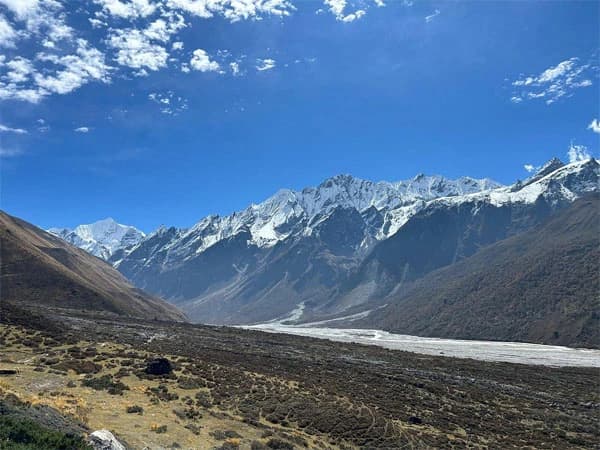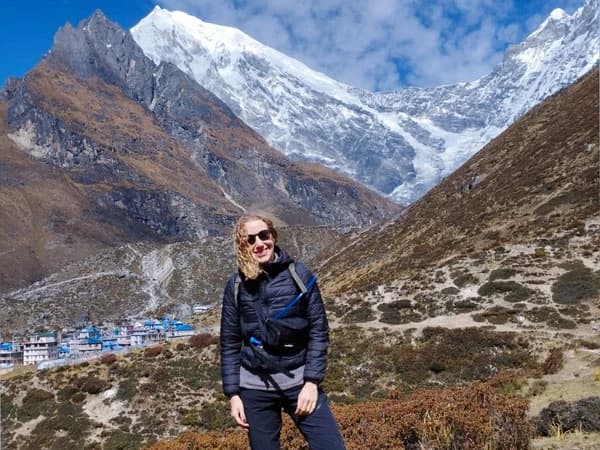Getting to Kyanjin Gompa
Your journey to Kyanjin Gompa starts with a long, bumpy drive from Kathmandu to Syabrubesi. This road trip takes about 7 to 9 hours, depending on the road and weather. You’ll drive through hills, rivers, and terraced farms. Though rough, the journey gives a first taste of what lies ahead: natural beauty, village life, and the promise of the mountains.
The trek indeed does require 3 to 4 days. The trail meanders through villages like Lama Hotel, Ghodatabela, and Langtang Village before you reach Kyanjin. Each day, you climb higher not just in altitude but in appreciation too. You will trek above rhododendron woods, stone settlements, yak grass grazing lands, and stunning river scenes. Once you reach Kyanjin Gompa, the air is thin and sharp, but the scenery is just gorgeous.
First Impressions of Kyanjin Gompa
When you reach the village after trekking all day, it is peaceful and serene. The mountains appear close by, as if standing above you to protect you. The sky appears bigger, too. Prayer wheels, tiny stone houses, and Buddhist flags decorate the village. Yaks graze peacefully in the distance. Wind sounds mixed with soft prayers provide a dreamy ambiance. The village is small but has everything: hot food, tea houses, basic rooms, and nice people. At the heart of everything is the monastery itself, basic but very devout.
History and Importance of Kyanjin Monastery
The name "Kyanjin Gompa" is derived from this small monastery that has existed here for over 300 years. It has been a Nyingma school of Tibetan Buddhism and religious settlement center for centuries now among the local Tamangs.
Although the monastery itself is not as imposing and large as those of Tibet or Kathmandu, it is one that is full of importance. There are centuries-old statues, prayer books, thangka paintings, and incense that fills the air with a calming scent. Monks still live and meditate in the monastery, and their chanting can be heard echoing in the early morning or late afternoon.
Tourists come to Kyanjin not just to see the monastery but to experience the peacefulness that surrounds it. The locals regard the area as sacred, encircled by mountains and blessed by their forebears.
The Cheese Factory: A Tasty Surprise
One of the most fascinating features of Kyanjin Gompa is its yak cheese factory. Having a factory to provide sanctuary for cheese production in such a remote town might sound unusual but has its roots centuries ago. It began many years ago in the 1950s with the aid of the Swiss government and has been running under the patronage of the Nepalese government.
Trekkers can even visit the factory, where they get the opportunity to see with their own eyes how the milk from local cows and yaks is processed into cheese. They can taste freshly prepared curd, buy packaged yak cheese, or even have rich, traditionally made yogurt ready for them. It's a small thing, but there is nothing quite like dining al fresco off a cup of tea and some new yak cheese, surrounded by white mountains in every direction, that you'll never forget.
Side Trips and Viewpoints Around Kyanjin Gompa
While the walk to Kyanjin Gompa is almost an arrival point, it's also where so many of the other treks depart from. Most travelers take a few extra days here, getting a feel for what's nearby.
Tserko Ri (4,984 meters)
This is quite possibly one of the most satisfying treks in the Langtang area. Tserko Ri is a very long, inclining trek, typically done early in the morning. The path takes you over yak grazing pastures, exposed hill slopes, and boulder fields. After 4 or 5 hours of ascending, you finally arrive at the summit. You get a 360-degree view of Langtang Lirung, Dorje Lakpa, Yala Peak, and even the Tibet border from the top. The sun rises to cast pink and golden shadows on the peaks, a sight that most believe is the most breathtaking experience on their trek.
Kyanjin Ri (4,773 meters)
Kyanjin Ri is a relatively less challenging climb but also has super views. It could be climbed as a half-day climb. The route begins directly from the village and ascends steadily to a boulder ridge. It boasts glaciers, the Langtang River, and limitless snow peaks all around at the top.
Langshisha Kharka
It is a longer but easier trek. You hike in level river bottoms to the east, through yak grazing grounds and little streams. It's an excellent method of enjoying the untouched beauty of the region with very little climbing. It's done by many as a day hike with a picnic lunch.
Wildlife and Natural Beauty
Kyanjin Gompa lies inside Langtang National Park, a forest park with a dense cover of vegetation and rich flora and fauna. While you trek to or from the village, you will be able to see some wildlife, such as Himalayan tahr, musk deer, langur, and even red pandas if you are fortunate. Nature enthusiasts will also find it enjoyable to spot different bird species, including Himalayan monals, snow pigeons, and bearded vultures. In spring, red and pink flowers blanket the rhododendron forests. Autumn has clear skies and clean air. Each season is pretty in its respective way.
Culture and Traditions
Tamang dominates Kyanjin and Langtang as a whole as an ethnic group brought about by Tibetan culture. The Tamang are Tibetan Buddhists and have maintained their culture for centuries. You can observe the natives praying in revolving prayer wheels, burning butter lamps, and donning traditional attire. They construct their wooden and stony homes, and their lives are not complex but rich in values. Hospitality is a part of the culture. People, regardless of the difficulties of mountain life, are hospitable and friendly. Social gatherings over food, welcoming visitors to hot tea, and exchanging smiles with visitors are common practices.
The Earthquake and Rebirth
In 2015, Nepal was struck by a devastating earthquake that leveled Langtang Valley. Villages were destroyed by landslides, and scores of lives were lost. Kyanjin Gompa was also shaken but survived better than some places. Villagers have rebuilt their homes, teahouses, and lives since then. The village is prospering today as a testament to hope and human beings' very instinctive love for nature. Traveling to Kyanjin today also involves supporting the economy and paying respects to their resilience.
Accommodation and Food
There are a few teahouses and lodges at Kyanjin Gompa with simple but clean rooms. These typically have twin beds, warm quilts, and solar electricity supply. Hot showers are provided by some of them at an extra cost.
The food is typically Nepali or Tibetan in nature dal bhat, noodles, fried rice, momos, soups, and, of course, yak cheese and yogurt. Herbal teas, ginger lemon honey, and instant coffee are served. The food is simple but healthy, just what one requires after days of hiking.
Best Time to Visit Kyanjin Gompa
Spring (March to May)
Spring brings gentle warmth back to the Langtang Valley. As one ascends from the Lama Hotel up to Kyanjin Gompa, there is a dense air of green leaves pushing out new and tiny wildflowers fighting their way through sodden ground. Rhododendron forests erupt into short bursts of red, pink, and white flowers, coloring hillsides in mottled hues of pale color. Clear skies in the morning give way to a few passing clouds in the afternoon, so you’ll enjoy crisp mountain panoramas at dawn and a pleasant, cool breeze by midday. Nights can still feel chilly so pack a warm layer, while daytime highs hover around 10-15 °C, perfect for exploring gompas and yak-cheese huts without rushing.
Autumn (September to November)
After the monsoon withdraws, autumn offers the clearest views and calmest trails. The world is drying out, with rock steps hard underfoot and puffed-up snowmelt rivers only. Ridges on either side of Tserko Ri glint gold in the morning; the sun is at your back while you have a go at the valley's famous fresh yogurt at midday. Days are 8-12 °C, collapsing to near freezing once darkness has fallen, so layers are vital. This is the high season, with trekkers being prepared to encounter groups of trekkers at teahouses and village harvest festival celebrations, so that it's never hard to sit down and swap stories over steaming ginger tea.
Winter (Dec to Feb)
Winter treks to Kyanjin Gompa demand tough gear and a tough disposition. Trails are likely to be dry or snowy, and gaiters and sound boots are essential. Mornings are rusty with frost, and crystal mornings see sunshine on frozen ridges, throwing out fiery blue shadows on the valley floor. Daytime temperatures are likely to be between -5 °C and 5 °C higher up, but a down jacket and insulated gloves will do on long stops. The reward is loneliness: peaceful monasteries, unbroken snowfields, and the chance to watch reluctant mountain animals against an albino landscape.
Monsoon (June to August)
Monsoon awakens Langtang's forests but with a catch. Rain transforms trails into soggy girdles of mud and river crossings into more adventurous experiences, so be equipped with waterproof gear and trekking poles. Dripping cloud cover typically shrouds the summits, hiding them for days on end, but sometimes you catch a glimpse through a gap-through jade-green hillside vistas. It is between 7 °C and 14 °C with cold and damp nights. If you like empty trails and don't care if the poncho does get wet, there are misty early morning panoramas and near-empty tea-houses, offering a classically serene walk.
How to Prepare for the Trek
- Permits: You need a TIMS card and a Langtang National Park Entry Permit.
- Guides and Porters: Hiring a guide adds safety and insight, while a porter helps carry your load.
- Altitude: Acclimatization is important. Take your time and don’t rush the trek.
- Packing: Bring warm clothes, a good sleeping bag, sunscreen, and water purifiers. Proper hiking boots and trekking poles are helpful.
- Connectivity: Mobile signal is weak or unavailable. A few lodges offer limited Wi-Fi.
- Cash: There are no ATMs after Syabrubesi. Carry enough Nepali rupees.
Conclusion
The delicate charm of Kyanjin Gompa is not just about disciplinary treks and summits; it's about the quiet moments that linger. Just sit where you are and listen: wind stirs between multicolored prayer flags, with the soft murmurs of old prayers drifting down into the valley. In a wee stone teahouse, a grandmother greets you with friendly smiles and pours you butter tea from new yak milk. Her plain generosity stretches as far as the mountains around.
You may walk during the day on arid trails under a burnished blue sky. The White Mountains loom up unobtrusively, and in the silence you are provided space to catch your breath, to think, or simply to be. Kyanjin Gompa does not beckon you. Instead, it greets you softly, with calm, with beauty, and with the sense that you are somewhere true.
Whatever led you here, i.e., a spiritual getaway, mountaineering adrenaline, or simply a retreat from life's whirlpool. Kyanjin Gompa has it all in store for you. It boasts no pretension of show, only moments of rest in silence: a prayer wheel spinning with the breeze, grins over meals consumed, and the firm quiet of Himalayan respiration. You find here that the most rewarding experience is to do less and be.
In a mad world of rushing automobiles, televisions, and stress, Kyanjin Gompa gives something serene and beautiful. Time moves slowly there. Deadlines are of no consequence. The stars don't need to be watched. Life is simple, and out of simplicity perhaps you would find something that you never realized you were looking for. So dream of Himalayan trekking in Nepal, and don't merely look to the summits or most celebrated treks. Look at Kyanjin Gompa, take the serene trail, listen for the mountains, enjoy fresh yak cheese, and sit beneath fluttering prayer flags. You won't regret visiting this awe-inspiring place.





